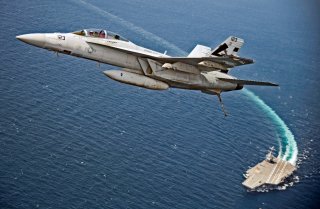Can 'Block Buys' Get the Navy Its Aircraft Carriers Faster?
The Navy wants to make sure that its much-needed fleet of carriers is delivered on time.
With China making progress on its third aircraft carrier and planning to build several more as quickly as possible, the U.S. Navy is taking steps to ensure that it stays on track with the production and delivery of its emerging fleet of Ford-class aircraft carriers.
China now operates two aircraft carriers, the Soviet-built Liaoning and the indigenously-built Shandong. The People’s Liberation Army Navy has already conducted dual-carrier patrols and power projection drills operating both carriers together, and China is working to accelerate the construction of a third carrier. China is leveraging its large industrial base and shipbuilding capacity to build its own fleet of carriers. Notably, rather than using a curved deck, the third Chinese carrier appears designed to mirror the USS Ford’s flat carrier deck.
While the U.S. Navy currently operates a much larger carrier fleet and can project more power than China, Pentagon leadership is taking critical steps to ensure the growing fleet of Ford-class carriers is produced efficiently. The Ford-class introduces an entire suite of paradigm-changing technologies specific to carrier air wing power projection, and the Navy wants to make sure that its much-needed fleet of carriers is delivered on time.
The Navy and its many shipbuilding industry partners have been pursuing a “two-ship” purchase strategy to consolidate funding and acquisition practices for two separate carriers. The service already used the “block buy” technique with the third and fourth Ford-class carriers. This strategy helped consolidate and streamline the purchase and delivery of crucial supplies and “long-lead items,” or key elements of the ship that need to be acquired in advance of construction.
The concept of a two-ship “block buy” synergizes the acquisition of crucially needed material to ensure there are sufficient supplies for the Navy’s ambitious ship-building schedule.
“We hope that when we get to the 2024 budget, we start getting the same funding for CVN 82 and CVN 83 as a block buy with advanced planning funds to help suppliers buy materials in advance. Some of these are products that are needed earlier in the developmental cycle,” Richard Giannini, CEO of the Milwaukee Valve Company and chairman of the Aircraft Carrier Industrial Base Coalition (ACIBC), told the National Interest in an interview.
The ACIBC exists to help marshal support for the robust production capacity needed for the acquisition and modernization of the carrier fleet. ACIBC includes as many as 2,000 individual suppliers from almost every state and a skilled workforce that needs to be maintained and replenished as needed, Giannini said. Part of this includes efforts to find, train, and retain highly skilled machinists and workers capable of supporting aircraft carrier construction.
Kris Osborn is the Defense Editor for the National Interest. Osborn previously served at the Pentagon as a Highly Qualified Expert with the Office of the Assistant Secretary of the Army—Acquisition, Logistics & Technology. Osborn has also worked as an anchor and on-air military specialist at national TV networks. He has appeared as a guest military expert on Fox News, MSNBC, The Military Channel, and The History Channel. He also has a Master’s Degree in Comparative Literature from Columbia University.
Image: Reuters.

